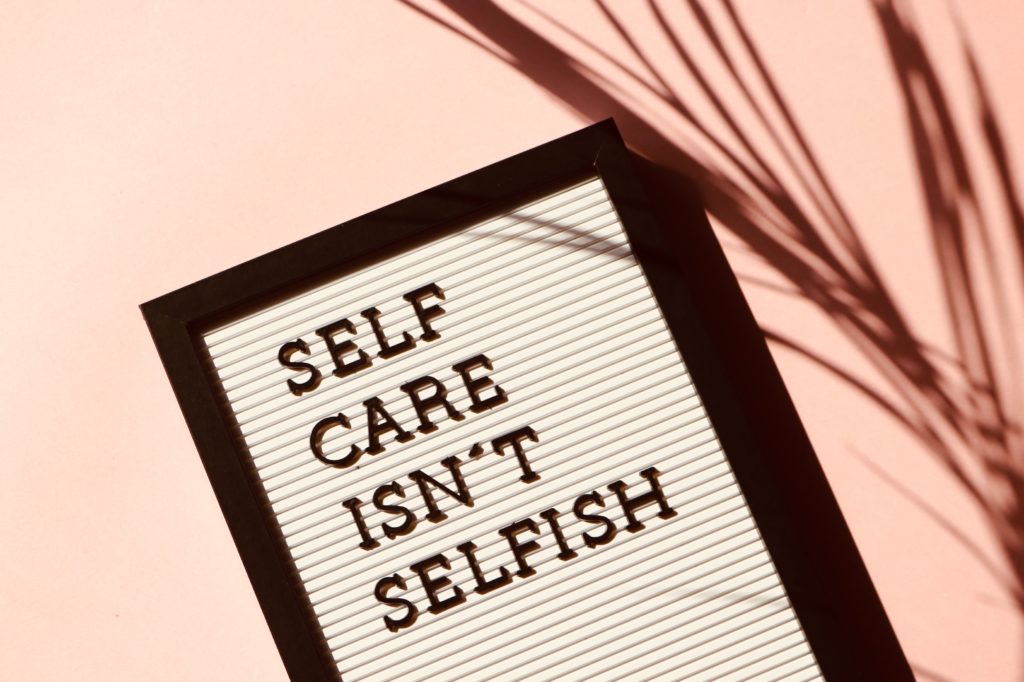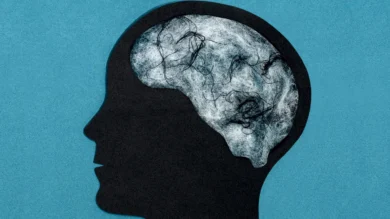It really hit me when I was planning our family vacation to Disneyworld a little over a year ago.
It was supposed to be an epic family vacation, both my own family of five and my sister’s family would be going together. I wanted everyone to remember this vacation and fully experience the magic of Disneyworld. After all, it is supposed to be the happiest place on earth.
I wanted everything to go perfectly. I began planning the vacation down to the minute, with back up plans in place should anything fall through. But the planning felt like it would never end and it became overwhelming at times. I began to struggle with simple decisions, like which restaurant to make a reservation at, or what colour our custom-made Mickey Mouse family t-shirts should be.
I didn’t realize it at the time, but the stress I put on myself led to physical sensations like heart pain and chest pressure. I didn’t know what was happening to me and had no words to accurately describe the physical symptoms that were manifesting as a result of this stress. I later learned that the word was anxiety.
But how did I get here?
This is my story.
The Perfect Storm for a Perfectionist
I’ve been a perfectionist and goal-setter all my life. Being the eldest of three, I felt the pressure of being the perfect role model for my siblings and the perfect daughter for my parents. I was a people-pleaser from day one – wanting my teachers and classmates to not only like and accept me but be proud of me too.
My high self-expectations followed me well into adulthood; I wore my perfectionism like a badge of honour. I was a high achiever in both school, work, and life. I graduated from a prestigious university with a senior-level TA experience under my belt. I attained multiple degrees and landed a job at a prominent Board of Education right out of university. I married my best friend and had three beautiful, perfect children.
But perfectionism is an insidious friend. It lures you in with promises of achievements and rewards but is unsustainable and dangerous to your state of mind. The higher you climb, the higher the bar is set. This meant that I needed to achieve even more to feel the same sense of pride in meeting my expectations. I found that setting expectations that seemed unattainable became a game to me – I knew there was nothing I couldn’t do without hard work and my very best efforts. The drive to achieve, to be the best at whatever I put my mind to was reinforced by meeting my goal time after time.
As my journey moved into motherhood, my priority became giving my three young children the best possible life. I constantly felt the pressure of having only one shot to make their childhood magical. It was my utmost priority to make sure that they had all the support, love and advocacy they needed to grow up confident, with rich experiences, and a strong, loving family unit. While I didn’t see it happening at the time, my stress level was steadily increasing.
My expectations were further fuelled whenever I saw Instagram moms with their perfect lives – perfect crafts, memories, children who never seemed to fight, endless patience, and an infinite budget for fun and travel. It made me want to keep up, even when I knew it wasn’t realistic. There was no possible way I could compete and I felt like a failure simply by observing. What did this mean for my kids? If I couldn’t keep up, how would they grow up to be complete and whole individuals?
Holding myself to such a high standard is partly why I’ve excelled as an elementary educator. I’m the type of person who wants to give my all at every moment and in every task that I do. I really care about my students and want the best for them, even when it meant overextending myself emotionally and physically beyond what I can give at the moment. I reduced my contract position to part-time hours so that I could focus more on my students as well as my own children.
The weight of carrying all this pressure my entire life led to an inability to relax the goals and expectations I had set for myself. I was gradually draining my battery and started seeing the impact; I would feel calm and in control one minute, but then get triggered by small things and suddenly feel that I couldn’t cope. The best strategy seemed to be to micromanage myself, setting daily and weekly goals to keep me on track. I had never been comfortable with uncertainty, so I started laying out all the variables I could think of to plan for all the things that might happen in any given scenario. I was trying in vain to smooth the path for myself, for my children, my students, and for my husband.
What was really hard on me was when some of my family members couldn’t understand what was happening to me. They didn’t know what it was like to feel the burden of all the lifelong stress and anxiety on my shoulders, which was fostering a lot of unhealthy habits. It seemed like a simple and needless worry to them. They didn’t understand the feelings that I had – that the world wouldn’t run as smoothly, or that a ball would get dropped if I stopped my constant vigilance. I was unable to trust that anyone else could carry the ball or execute the plan with the same level of efficiency as I could. It came to a point when I reached out to my husband for support. I began to recognize that the weight I was carrying was too heavy, so I asked for help. But the help was denied, and moreover, demeaned. As I realized that I was alone in this battle, I dug even deeper and kept juggling everything.
Eventually, it came to an explosive and sudden head. I had a catastrophic falling out with my husband, which led to us separating. The experience was really traumatic for me and I needed to immediately take time off work. My employer referred me to our insurance provider for additional support, which is where I first heard about the Starling Minds program.
Self-Discovery and Shifting Perspective
Initially, I was looking for face-to-face therapy and wanted to use Starling Minds to supplement the counselling sessions. However, as I went through the online CBT program, I found that Starling Minds’ therapy tools worked perfectly in tandem with my face-to-face therapy sessions. It strengthened my understanding of mental health, neurological patterns and unhealthy pathways I’ve created my entire life. I found myself referencing tools I learned from Starling during counselling and vice versa.
“It’s mind-boggling how much of a difference these tools have had in my life. 6 months later, I’m in a much better place and I feel like a different person.”
Mental Health Tools that Worked
I used to be the type of person who could not let things go. Managing uncertainty became a full-time job. I was prone to rumination and overthinking, and I needed a lot of reassurance from others as a way of managing my anxiety. Changing my negative thought patterns and creating empowering ones has been challenging, as most of my thoughts have been with me for a very long time and ingrained in my mind. Three tools were essential in helping me learn how to let things go.
Goal Setting with a new attitude
- As a high achiever, I was prone to creating unsustainable goals when I was recovering and rebuilding myself. This was evident when I was using Starling Minds to practice goal setting. One of my goals was to put in time playing my guitar. I’ve never played it before, but it became something that brought me joy and comfort. I used Starling’s goal-setting tool and set my goal to pick up my guitar and play for just 5 minutes a day. However, being the perfectionist that I was, I was anxious with all the pressure I was putting on myself to play. I found myself putting it off over and over again.
- As I learned more about myself, my processes, and my self-imposed limitations from Starling Minds, I carefully considered my goal. Even though it seemed ridiculous that 5 minutes was unachievable, the program guided me to lessen the goal until it was at an achievable level. Eventually, I set a new goal: I would play my guitar for just 2 minutes that week, and then put it down immediately. By giving myself permission to set a timer and stop after 2 minutes, I felt the weight of the pressure lift off me. And I did it, I achieved the goal! I then regrouped and set a new one.
This experience really helped adjust my outlook on goal setting. The part that was really tough about this exercise was modifying my expectations from when I was at my peak, to what I was capable of as a person recovering from trauma. Each time I lowered the bar, it felt like I wasn’t the best version of myself, and a failure somehow. That was a really hard feeling to reconcile.
It made me realize that I needed to give myself permission to set smaller goals so that I can set myself up for success; to achieve my goals and also motivated for the next milestone. It helped me understand that growth doesn’t always look like a straight line; the learning is in the process, not just the end achievement, and there will be many times in life when we need to adjust our goals. This is not a reflection of failure, rather one of true success and an adaptable mindset.
Managing my Anxiety Curve
- My counsellor taught me the concept of the anxiety curve. For example, thinking about planning a big trip would give me anxiety. If I decided to just cancel my trip altogether, I felt the anxiety drop instantly. But this was only a temporary fix. The next time something similar came up that I couldn’t put off, my anxiety curve would be much higher. I learned that rather than avoiding the situation, I should use the tools and strategies I’ve learned through Starling Minds to manage my anxiety; it actually lowers the curve for the next time. Each time I was able to successfully navigate this, my anxiety lessened and the curve flattened to a manageable level.
- I now choose to take a more proactive approach and make choices that might make me feel more anxious in the moment but less anxious in the future. I try to power through and manage the anxiety as best as I can while tackling the task at hand, making sure to utilize the tools I have armed myself within my personal mental health toolbox.
Letting go of reassurance strategies and embracing evidence-based thoughts
- Previously, I used “What if” thoughts to strengthen negative thought patterns. I was deeply fearful of people being upset with me and used reassurance strategies to lower my anxiety. If I thought that someone was upset with me, I would follow up to check-in and apologize for things that I wasn’t really responsible for. There was nothing more important than smoothing a rocky situation, even if it came at a personal cost.
“I had wired my brain to be fearful of upsetting people since childhood. Why did I do that and how could I possibly reroute this pathway to take its power away? I began to see how unhealthy it had become and how it had eroded me over time.”
After learning about the concept of evidence-based thoughts, I’ve shifted my focus to thought balancing and used evidence-based thoughts to disprove negative thoughts. Now, if I suspect that someone is upset with me, I ask myself why. This has really helped me with excessive rumination and attention. Constantly looking for reassurance was a hard way to live; the fact that I can now evaluate logically based on reason and let things go was absolutely life-changing. While I can balance some thoughts in my mind and on the fly, others are bigger and require me to sit down and complete a thought record – looking for evidence to support the negative thought as well as evidence that the negative thought is just that, thought and not a fact. It takes practice but has proven to be well worth the effort.
Expecting Less without Feeling Less
On my journey, one of the most valuable things I learned was to give myself permission to change my expectations without feeling less. Lessening the rigidity of the routines I had historically self-imposed has allowed me to reframe expectations of myself, others, and situations to a more realistic level. This has increased the likelihood of success for the desired outcome, reduced anxiety overall, and prevented me from constantly drawing on my emotional battery for added fuel.
Something I realized was that I consistently gave so much of myself to others, but wasn’t doing enough to care for myself physically and emotionally. As a mother, it was hard to tell my kids that I needed some time to myself, especially when they wanted to play or spend time with me. Starling helped me reconcile those feelings and realize that setting healthy boundaries for myself was not only allowing me to recharge my battery so that I had more fuel to give, but also modelling self-care and self-advocacy for my children.
The image of the safety procedures that airline stewardesses review before takeoff really resonated with me; understanding the reasoning behind putting on our own oxygen mask before assisting others helped me see that self-care wasn’t selfish. When we keep ourselves safe and healthy, we are better prepared to assist others with their own oxygen masks and be a guiding light during their storms. I know for me, my perfect storm had been brewing for years and when something exceptionally terrible happened, I just didn’t have enough energy left in my battery to cope, or the tools in my toolbox to even begin to navigate independently.
Returning to Work and Sharing my Toolbox
As I progressed with my learning through Starling, I began to feel as though I was in possession of all kinds of secret tools and strategies. When I spoke with friends and co-workers, I could see so clearly that they were looking through the same clouds of anxiety and uncertainty that I had been. I felt passionate that everyone could benefit from the knowledge and tools I learned, not just teachers. While the situation that brought me to Starling Minds was a devastating chapter in my story, it also was a true turning point for me. I’m grateful that I was connected with a program that has armed me to tackle my future with confidence, and the knowledge that even when hard times come again, I will be better able to rise to the challenge.
Before I went on leave from work, my position in my school was to teach Health to students in Grades 1 through 4. A new strand had been introduced into the school curriculum this year: Mental Health, with the thread of Social-Emotional Awareness Skills woven throughout. Upon my return to work, this has become the most intriguing part of the curriculum for me. Through my journey, I realized that many of the skills that parents and educators have often assumed that children naturally absorbed along the way actually needed to be explicitly taught.
I felt motivated to start the process of sharing my secret toolbox with my students. It didn’t make sense to me that people needed to wait for a crisis to learn how to balance their mental health. Imagine the possibilities for these little people if they became aware of negative thought patterns and began to reroute them before they become problematic and firmly entrenched! With these strategies, they will be better prepared to move forward into their own futures and to advocate for their educational and emotional needs.
“I’m grateful that as a result of my personal experiences, I have a set of tools that others in my position may not have. Now, I’m able to go forward and share it with others.”
It has been infinitely rewarding to see the positive impact these tools and strategies have had on my students. Due to the friendly and confidential nature of digital classrooms during this unprecedented time in Education, I found that I was receiving more honest opinions about worries and anxiety from my students; they were more willing to share what worries were on their minds. While there is no substitute for face-to-face learning with Elementary students, the reality of a classroom setting is that there is often not enough time to hear from all students, and also that not all students were comfortable openly sharing their thoughts and ideas in front of their peers.
No matter how much we have tried to shield our children from the realities of a global pandemic, we need to be acutely aware that they too have been touched by these events and have had their futures reshaped. They too need the opportunity to voice their worries and be taught how to balance their thoughts and see what they can control, and learn strategies to deal with the things that they cannot.
I feel so humbled and grateful that my students were very open-minded and took everything that I taught to heart. As the weeks went by, I could see the kids changing their thought patterns. It was deeply rewarding to see the impact of what I was trying to share from my journey begin to make a difference. In many cases, students volunteered that they were practising the tools and strategies that they learned with their parents, siblings and other loved ones.
Awareness around Mental Health in kids and adults is a topic that has slowly gained traction over the last few decades. Being able to witness the change in a provincial curriculum and having the opportunity to be on the ground floor implementing lessons and strategies that speak to this value has been a gift. Moreover, the fact that Starling Minds has outfitted me with the skills to build a toolbox and select the right tool for the job; self-advocate, and to have the permission to care for your emotional needs without shame is something that has changed the course of my life.
Mental Health is such a fundamental topic for overall wellness, and it’s definitely something that all Canadians need to be talking about more. I feel fortunate to be a part of that conversation.
As a reminder, if you are already a Starling Member be sure to log in to practice self-care at https://member.starlingminds.com.
Want to register? Reach out to us at members@starlingminds.com and we will help you get started!




